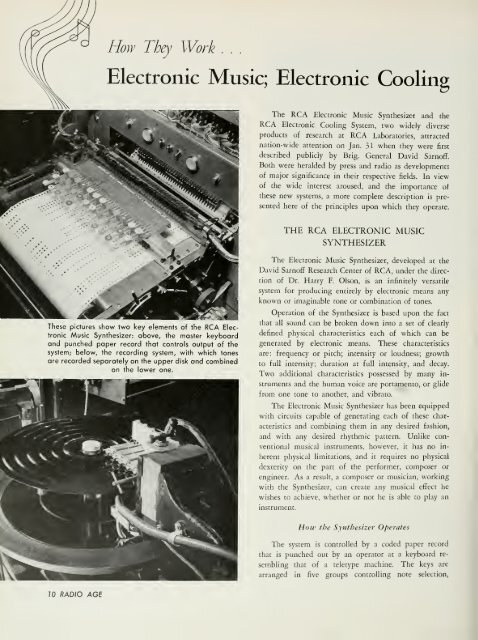Radio Age - 1955, April - 36 Pages, 2.8 MB, .PDF - VacuumTubeEra
Radio Age - 1955, April - 36 Pages, 2.8 MB, .PDF - VacuumTubeEra
Radio Age - 1955, April - 36 Pages, 2.8 MB, .PDF - VacuumTubeEra
You also want an ePaper? Increase the reach of your titles
YUMPU automatically turns print PDFs into web optimized ePapers that Google loves.
How They Work .<br />
. .<br />
Electronic Music; Electronic Cooling<br />
The RCA Electronic Music Synthesizer and the<br />
RCA Electronic Cooling System, two widely diverse<br />
products of research at RCA Laboratories, attracted<br />
nation-wide attention on Jan. 31 when they were first<br />
described publicly by Brig. General David Sarnoff.<br />
Both were heralded by press and radio as developments<br />
of major significance in their respective fields. In view<br />
of the wide interest aroused, and the importance of<br />
these new systems, a more complete description is presented<br />
here of the principles upon which they operate.<br />
THE RCA ELECTRONIC MUSIC<br />
SYNTHESIZER<br />
The Electronic Music Synthesizer, developed at the<br />
David Sarnoff Research Center of RCA, under the direction<br />
of Dr. Harry F. Olson, is an infinitely versatile<br />
system for producing entirely by electronic means any<br />
known or imaginable tone or combination of tones.<br />
These pictures show two key elements of the RCA Electronic<br />
Music Synthesizer: above, the master keyboard<br />
and punched paper record that controls output of the<br />
system; below, the recording system, with which tones<br />
are recorded separately on the upper disk and combined<br />
on the lower one.<br />
Operation of the Synthesizer is based upon the fact<br />
that all sound can be broken down into a set of clearly<br />
defined physical characteristics each of which can be<br />
generated by electronic means. These characteristics<br />
are: frequency or pitch; intensity or loudness; growth<br />
to full intensity; duration at full intensity, and decay.<br />
Two additional characteristics possessed by many instruments<br />
and the human voice are portamento, or glide<br />
from one tone to another, and vibrato.<br />
The Electronic Music Synthesizer has been equipped<br />
with circuits capable of generating each of these characteristics<br />
and combining them in any desired fashion,<br />
and with any desired rhythmic pattern. Unlike conventional<br />
musical instruments, however, it has no inherent<br />
physical limitations, and it requires no physical<br />
dexterity on the part of the performer, composer or<br />
engineer. As a result, a composer or musician, working<br />
with the Synthesizer, can create any musical effect he<br />
wishes to achieve, whether or not he is able to play an<br />
instrument.<br />
How the Synthesizer Operates<br />
The system is controlled by a coded paper record<br />
that is punched out by an operator at a keyboard resembling<br />
that of a teletype machine. The keys are<br />
arranged in five groups controlling note selection,<br />
10 RADIO AGE
















